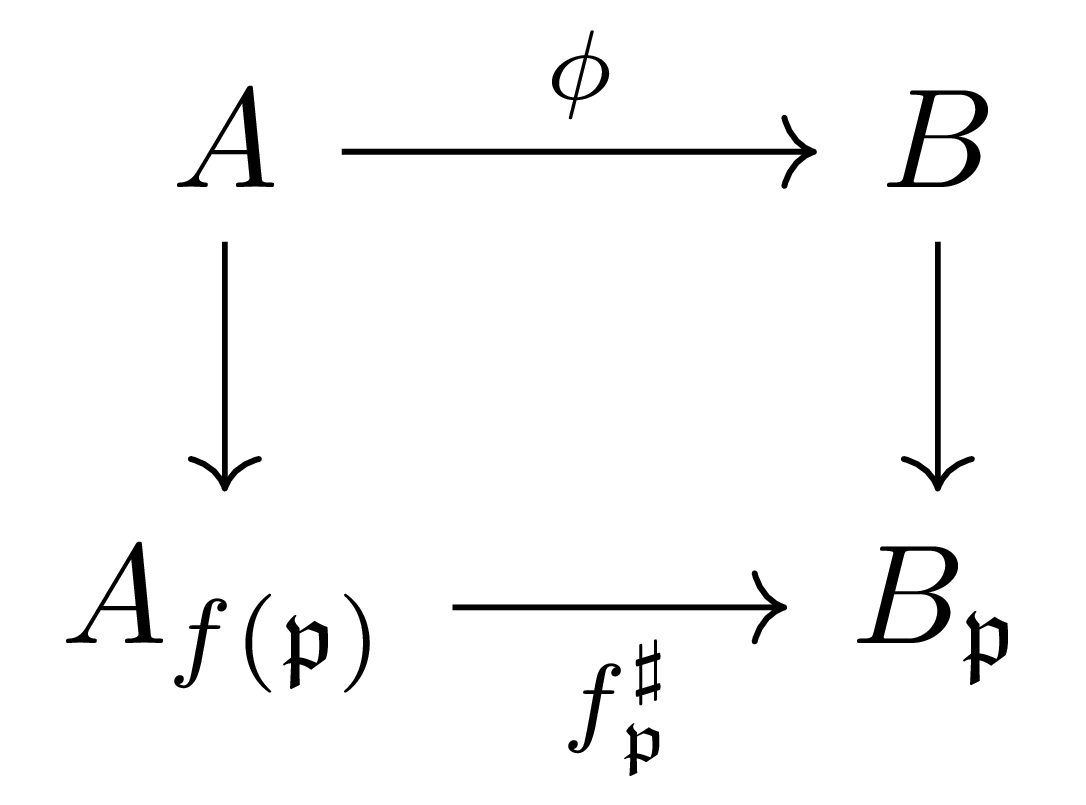스킴의 정의
이제 우리는 스킴이 무엇인지를 정의할 수 있다.
정의 1 Locally ringed space $(X, \mathscr{O}_X)$가 scheme스킴이라는 것은 임의의 $x\in X$가 주어질 때마다, $x$의 열린근방 $U$가 존재하여 $(U, \mathscr{O}_X\vert_U)$가 affine scheme이도록 할 수 있는 것이다. Scheme들 사이의 morphism과 isomorphism의 개념은 locally ringed space로서의 그것들로 정의된다.
Scheme $X$의 임의의 점 $x\in X$가 주어졌다 하고, $x$의 affine open neighborhood $U$를 택하자. 그럼 정의에 의해 적절한 ring $A$가 존재하여 locally ringed space로서 $(U, \mathscr{O}_X\vert_U)\cong (\Spec A, \mathscr{O}_{\Spec A})$이다. 특히 위의 isomorphism을 통해 $x\in U$에 대응되는 $\Spec A$의 점을 $\mathfrak{p}_x$라 하면,
\[\mathscr{O}_{X,x}=\varinjlim_{V\ni x} \mathscr{O}_X(V)=\varinjlim_{U\supseteq V\ni x} \mathscr{O}_X(V)=\mathscr{O}_{U, x}\cong \mathscr{O}_{\Spec A, \mathfrak{p}_x}\tag{$\ast$}\]임을 안다.
일반적으로 affine scheme $(\Spec A, \mathscr{O}_{\Spec A})$를
을 통해 항상 affine scheme이 된다.
보조정리 2 Affine scheme $\Spec A$와 $f\in A$에 대하여, $D(f)$는 위의 isomorphism ($\ast\ast$)를 통해 항상 affine scheme이 된다.
증명
우리는 §스펙트럼, ⁋명제 9의 셋째 결과로부터 위상공간 사이의 injective continuous map $\Spec\epsilon: \Spec A_f \rightarrow A$가 homeomorphism $D(f)\cong \Spec A_f$를 주는 알고 있지만, 위의 isomorphism을 정당화하기 위해서는 이를 scheme morphism으로서 정당화해야 한다.
우선 ring homomorphism $\epsilon: A \rightarrow A_f$는 scheme morphism
\[(\Spec \epsilon, (\Spec\epsilon)^\sharp): (\Spec A_f, \mathscr{O}_{\Spec A_f}) \rightarrow (\Spec A, \mathscr{O}_A)\]을 유도하며, 이 때 $D(f)$와 $\Spec A_f$ 사이의 homeomorphism은, canonical inclusion $\iota: D(f)\hookrightarrow \Spec A$를 생각하면, 다음의 decomposition

으로부터 나온다. 이제 위의 isomorphism ($\ast\ast$)이 scheme들 사이의 isomorphism이기 위해서는 homeomorphism $\Spec\epsilon\vert^{D(f)}$에 대응되는 $\Sh(D(f), \cRing)$에서의 morphism $(\Spec\epsilon\vert^{D(f)})^\sharp$을 정의해야 한다. 그럼 [위상수학] §층, ⁋예시 12에 의하여
\[(\Spec\epsilon\vert^{D(f)})^\sharp: \mathscr{O}_{D(f)} \rightarrow (\Spec\epsilon\vert^{D(f)})_\ast \mathscr{O}_{\Spec A_f}\]를 정의하는 것은
\[(\Spec\epsilon\vert^{D(f)})^{\sharp}: \iota^{-1}\mathscr{O}_{\Spec A} \rightarrow (\Spec\epsilon\vert^{D(f)})_\ast \mathscr{O}_{\Spec A_f}\]를 정의하는 것과 완전히 같고, 다시 [위상수학] §층, ⁋보조정리 11에 의하여
\[\begin{aligned}\Hom_{\Sh(D(f), \cRing)}(\iota^{-1}\mathscr{O}_{\Spec A}, (\Spec\epsilon\vert^{D(f)})_\ast\mathscr{O}_{\Spec A_f})&\cong \Hom_{\Sh(\Spec A, \cRing)}(\mathscr{O}_{\Spec A}, \iota_\ast(\Spec\epsilon\vert^{D(f)})_\ast \mathscr{O}_{\Spec A_f})\\&\cong \Hom_{\Sh(\Spec A, \cRing)}(\mathscr{O}_{\Spec A}, (\iota\circ\Spec\epsilon\vert^{D(f)})_\ast \mathscr{O}_{\Spec A_f})\\&=\Hom_{\Sh(\Spec A, \cRing)}(\mathscr{O}_{\Spec A}, (\Spec\epsilon)_\ast \mathscr{O}_{\Spec A_f})\end{aligned}\]이므로 $(\Spec\epsilon)^\sharp:\mathscr{O}_{\Spec A} \rightarrow (\Spec \epsilon)_\ast \mathscr{O}_{\Spec A_f}$를 통해 $(\Spec\epsilon\vert^{D(f)})^\sharp$을 정의할 수 있으며, 이것이 isomorphism인 것은 해당 보조정리의 증명을 따라가보면 본질적으로 $\Spec A_f$가 $\Spec A$의 열린집합이기 때문에 보일 수 있다.
특히 scheme을 정의에 의해 affine scheme들로 덮을 수 있고, 이들은 principal open set으로 이루어진 base를 가지므로 임의의 scheme은 affine open subset들로 이루어진 base를 갖는다.
다음 보조정리는 비슷한 논증을 통해 scheme의 임의의 열린집합은 항상 scheme이라는 것을 보여준다.
보조정리 3 Scheme $(X, \mathscr{O}_X)$의 임의의 열린집합 $U$가 주어졌다 하자. 그럼 $(U, \mathscr{O}_X\vert_U)$도 scheme이다.
증명
열린집합 $U$의 임의의 점 $x$가 주어졌다 하자. 우선 $X$는 scheme이므로, $x$의 적당한 ($X$에서의) 열린근방 $V$와 ring $A$가 존재하여 $(V, \mathscr{O}_X\vert_V)\cong(\Spec A, \mathscr{O}_{\Spec A})$이도록 할 수 있다. 또, $U$가 열린집합이므로 $U\cap V$는 $V$의 열린집합이다. 이제 §스펙트럼, ⁋보조정리 11에 의하여 다음의 식
\[U\cap V=\bigcup_{i\in I} D(f_i)\qquad\text{in $\Spec A$}\]을 만족하는 $f_i\in A$들이 존재하며, 따라서 어떠한 $i$에 대해 $x\in D(f_i)$이다. 이제 $(D(f_i), \mathscr{O}_X\vert_{D(f_i)})$는 affine scheme이고 $x\in D(f_i)\subseteq V$이므로 원하는 결과를 얻는다.
정의 4 Scheme $(X, \mathscr{O}_X)$의 임의의 열린집합 $U$에 대하여, scheme $(U, \mathscr{O}_X\vert_U)$를 $X$의 open subscheme열린 부분스킴이라 부른다.
스킴 위에 정의된 대수적인 함수들
§아핀스킴, §§$\Spec A$ 위에 정의된 대수적인 함수들에서 우리는 임의의 점 $\mathfrak{p}$에서 함수 $f\in A$의 함숫값을 $A/\mathfrak{p}$에서의 $f$의 image로 생각하기로 했었다. 이를 일반적인 scheme $(X, \mathscr{O}_X)$에 바로 적용하는 것은 조금 까다로운데, 위의 과정이 $(X, \mathscr{O}_X)$에서는 명확하지 않을 뿐더러, 예를 들어 $x\in X$의 affine open neighborhood를 사용하여 위의 논의를 반복한다 하여도 이것이 affine open neighborhood의 선택에 의존하지 않는다는 것이 보이지 않기 때문이다.
이를 해결하기 위해 우리는 조금 머리를 써서 다음을 정의한다.
정의 5 Scheme $(X, \mathscr{O}_X)$의 임의의 점 $x\in X$와 local ring $(\mathscr{O}_{X, x}, \mathfrak{m}_x)$를 생각하자. 그럼 $X$의 $x$에서의 residue field잉여류체는 $\mathscr{O}_{X,x}/\mathfrak{m}_x$로 정의되며, 이를 $\kappa(x)$로 적는다. 점 $x$를 포함하는 열린집합 $U$ 위에서 정의된 함수 $f\in \mathscr{O}_X(U)$에 대하여, $f$의 점 $x$에서의 함숫값은 $f$의 $\kappa(x)$에서의 image로 정의한다.
Scheme $X$의 임의의 점 $x\in X$와 $x$의 affine open neighborhood $(U, \mathscr{O}_X\vert_U)\cong(\Spec A, \mathscr{O}_{\Spec A})$를 택하자. 이 때, $x\in U$에 대응되는 $\Spec A$의 점을 $\mathfrak{p}_x$라 적는다면, 앞선 isomorphism ($\ast$)에서 우리는 $\mathscr{O}_{X,x}\cong \mathscr{O}_{\Spec A, \mathfrak{p}_x}$임을 확인하였고, 그럼 §아핀스킴, ⁋보조정리 8로부터 우리는 isomorphism
\[\mathscr{O}_{X,x}\cong \mathscr{O}_{\Spec A, \mathfrak{p}_x}\cong A_{\mathfrak{p}_x}\]를 얻으며 특히 이 isomorphism은 local ring $A_{\mathfrak{p}_x}$의 maximal ideal $\mathfrak{p}_xA_{\mathfrak{p}_x}$과 $\mathfrak{m}_x$를 대응시킨다. 따라서 [가환대수학] §국소화, ⁋정의 10의 정의를 생각하면
\[\kappa(x)=\mathscr{O}_{X,x}/\mathfrak{m}_x\cong A_{\mathfrak{p}_x}/\mathfrak{p}_xA_{\mathfrak{p}_x}=\kappa(\mathfrak{p}_x)\]를 얻는다. 한편 localization과 quotient는 commute하므로 ([가환대수학] §국소화의 성질들, ⁋명제 2) 우리는
\[\kappa(x)\cong A_{\mathfrak{p}_x}/\mathfrak{p}_xA_{\mathfrak{p}_x}\cong \Frac(A/\mathfrak{p}_x)\]를 얻으며, 따라서 정의 5가 affine scheme에서의 함숫값의 개념을 잘 일반화한다는 것을 안다. 그럼 이 표현에서, 임의의 $f\in \mathscr{O}_X(X)$에 대하여
\[X_f=\{x\in X\mid\text{$f_x\neq 0$ in $\kappa(x)$}\}=\{x\in X\mid f_x\not\in \mathfrak{m}_x\}\]으로 정의하자. 그럼 임의의 $x\in X_f$에 대하여, $x$를 포함하는 affine open neighborhood $U=\Spec A$를 택하면 위의 논의로부터 $U\cap X_f$는 열린집합 $D(f\vert_{U\cap X_f})$와 같다는 것을 알고, 따라서 §스펙트럼, ⁋보조정리 11로부터 $X_f$는 $X$의 열린집합임을 안다.
한편 점 $x\in X$에서 함수 $f$는 함숫값 뿐이 아니라, germ을 사용해도 살펴볼 수 있다. 다음을 정의하자.
정의 6 Scheme $(X, \mathscr{O}_X)$와 $f\in \mathscr{O}_X(X)$에 대하여, $f$의 support지지집합는 다음 식
\[\supp(f)=\{x\in X\mid f_x\neq 0\text{ in $\mathscr{O}_{X,x}$}\}\]으로 주어진다. 여기에서 $f_x$는 $f$의 $x$에서의 stalk을 의미한다.
그럼 만일 $x\in X$에서의 $f$의 stalk이 $0$이라면, $x$의 적당한 열린근방 $U=\Spec A$를 택하여 $f$가 $U$ 위에서 항등적으로 $0$이도록 할 수 있으므로 $\supp(f)$는 $X$의 닫힌집합임을 안다. 한편, 만일 $\mathscr{O}_{X,x}$에서 $f_x=0$이라면 $f_x$가 $\kappa(x)$에서 $0$인 것은 자명하므로 다음 포함관계
\[X\setminus \supp(f)\subseteq X\setminus X_f\iff X_f\subseteq \supp(f)\]가 성립한다.
스킴의 예시들
앞으로 편의상 scheme의 structure sheaf를 생략하여 $(X, \mathscr{O}_X)$ 대신 간단히 $X$로만 표기하고, scheme morphism도 $(\varphi, \varphi^\sharp)$ 대신 $\varphi$로만 표기하기로 한다.
예시 7 우리는 §스펙트럼, §§고전적인 대수기하학에서 (classical) affine $n$-space를
\[Z(\x(\x-1))=\mathbb{A}_{\mathbb{K},\mathrm{classical}}^n=\{(x_1,\ldots, x_n)\mid x_i\in \mathbb{K}\}=\mSpec \mathbb{K}[\x_1,\ldots, \x_n]\]으로 정의했었다. 이를 일반화하여 우리는 앞으로 $\mathbb{K}$ 위에서 정의된 affine $n$-space를
\[\mathbb{A}_\mathbb{K}^n=\Spec \mathbb{K}[\x_1,\ldots, \x_n]\]으로 정의할 것이다. 더 일반적으로, field $\mathbb{K}$를 임의의 ring $A$로 바꾸면 $A$ 위에서 정의된 affine $n$-space
\[\mathbb{A}_A^n=\Spec A[\x_1,\ldots, \x_n]\]를 얻는다.
Maximal spectrum $\mSpec A$에서 $\Spec A$로 넘어가는 것은 대수학을 쉽게 해 주기도 하지만, 기하학적으로도 의미가 있다. 이제 $\mathbb{A}^n$의 각 점들은, 전통적인 의미에서의 $n$-공간 $\mathbb{A}_{\mathbb{K},\mathrm{classical}}^n$에서의 점들만이 아니라, 이 공간에서 함수의 zero locus로 나타나는 닫힌집합들도 점으로 취급한다는 의미이다.
앞서 우리는 affine scheme의 열린집합이 affine scheme이 될 필요가 없다는 것을 언급했는데, 다음 예시가 이를 보여준다.
예시 8 Affine plane $\mathbb{A}_\mathbb{K}^2=\Spec \mathbb{K}[\x_1,\x_2]$를 생각하자. 그럼
\[\{(0,0)\}=Z(\x_1)\cap Z(\x_2)\]이므로 ${(0,0)}$은 닫힌집합이고, 따라서
\[U=\mathbb{A}_\mathbb{K}^2\setminus\{0\}=D(\x_1)\cup D(\x_2)\]는 열린집합이다. 한편, $D(\x_1)$과 $D(\x_2)$ 위에서 정의된 함수는
\[\mathscr{O}_{\mathbb{A}_\mathbb{K}^2}(D(\x_1))\cong \mathbb{K}[\x_1,\x_2]_{\x_1}=\mathbb{K}[\x_1,\x_2, \x_1^{-1}],\qquad \mathscr{O}_{\mathbb{A}_\mathbb{K}^2}(D(\x_2))\cong \mathbb{K}[\x_1,\x_2]_{\x_2}=\mathbb{K}[\x_1,\x_2, \x_2^{-1}]\]의 꼴이다. 이제 $D(\x_1)\cup D(\x_2)$ 위의 함수는 이들을 붙여서 만들 수 있는 함수들이며, 이러한 함수들은 교집합 $D(\x_1)\cap D(\x_2)=D(\x_1\x_2)$으로 제한했을 때 같은 함수여야 한다. 이제
\[\mathscr{O}_{\mathbb{A}_\mathbb{K}^2}(D(\x_1\x_2))=\mathbb{K}[\x_1,\x_2]_{\x_1\x_2}\]에서 $\mathscr{O}_{\mathbb{A}_\mathbb{K}^2}(D(\x_1))$의 원소들과 $\mathscr{O}_{\mathbb{A}_\mathbb{K}^2}(D(\x_2))$의 원소들을 비교해보면 이러한 함수들은 오직 다항함수 뿐이라는 것을 안다. 즉
\[\mathscr{O}_{\mathbb{A}_\mathbb{K}^2}(U)=\mathbb{K}[\x_1,\x_2]\]이다. 만일 $(U, \mathscr{O}_{\mathbb{A}_\mathbb{K}^2}\vert_U)$가 affine이었다면, $U$는 global section에 $\Spec$을 취해 얻어진 $\Spec \mathbb{K}[\x_1,\x_2]$와 isomorphic해야 할 것이지만, $U$에서 prime ideal $(\x_1,\x_2)$에 해당하는 점을 생각해보면
\[Z(\x_1,\x_2)=Z(\x_1)\cap Z(\x_2)=\emptyset\qquad\text{ in $U$}\]이므로 이는 불가능하다.
정의에 의해 scheme은 affine scheme들을 붙여서 만드는 것이며, 위의 예시에서도 $U$에서의 section을 계산하기 위해 이를 $D(\x_1)$과 $D(\x_2)$를 붙인 것으로 이해했다. 더 많은 예시들을 살펴보기 전에 다음 보조정리를 먼저 살펴보는 것이 다양한 예시들을 다루는 데 도움이 될 것이다.
보조정리 9 Index set $I$를 고정하고, 다음의 데이터들이 주어졌다 하자.
- Scheme들 $X_i$,
- $X_i$들의 open subscheme들 $X_{ij}$,
- 각각의 $i,j\in I$에 대하여, isomorphism들 $\varphi_{ij}:X_{ij} \rightarrow X_{ji}$
여기에서 $X_{ii}=X_i$이고 $f_{ii}=\id_{X_i}$인 것으로 정의한다. 그럼 만일 이들 데이터가 cocycle condition
\[\varphi_{ik}\vert_{X_{ij}\cap X_{ik}}=\varphi_{jk}\vert_{X_{ji}\cap X_{jk}}\circ \varphi_{ij}\vert_{X_{ij}\cap X_{ik}}\qquad\text{for all $i,j,k\in I$}\]을 만족한다면, 유일한 scheme $X$와 $X$의 open subscheme들 $U_i$가 존재하여, $U_i\cong X_i$이고 $U_i\cap U_j\cong X_{ij}$이도록 할 수 있다.
이에 대한 증명은 우선, 위상공간으로서 $\coprod X_i$를 생각하면 이 위에
\[(x_i, X_i)\sim (x_j,X_j) \iff \varphi_{ij}(x_i)=x_j\]을 통해 관계 $\sim$을 정의할 수 있으며, cocycle condition을 통해 이것이 동치관계임을 증명할 수 있다. 따라서 위상공간으로서 $X=\coprod_{i\in X_i}X_i\big/{\sim}$으로 정의하고, [위상수학] §준층, ⁋보조정리 1과 같은 방식으로 sheaf를 붙일 수 있다는 것을 확인하면 된다. 이를 통해 다음 예시를 보자.
예시 10 두 개의 affine line $X_0=\mathbb{A}_\mathbb{K}^1=\Spec \mathbb{K}[\x_0]$, $X_1=\mathbb{A}_\mathbb{K}^1=\Spec \mathbb{K}[\x_1]$, 그리고 이들의 열린집합
\[U_0=X_0\setminus \{(\x_0)\}=D(\x_0),\quad U_1=X_1\setminus \{(\x_1)\}=D(\x_1)\]이 주어졌다 하자. 그럼 정의에 의하여
\[\mathscr{O}_{X_0}(U_0)\cong \mathbb{K}[\x_0]_{\x_0}=\mathbb{K}[\x_0,1/\x_0]\]이고 비슷하게 $\mathscr{O}_{X_1}(U_1)\cong \mathbb{K}[\x_1,1/\x_1]$가 성립한다. 이번 예시에서 우리는 $X_0$과 $X_1$을 붙이는 두 가지 다른 방법을 구체적으로 살펴본다.
우선 isomorphism $\varphi:(U_0, \mathscr{O}_{X_0}\vert_{U_0})\rightarrow (U_1, \mathscr{O}_{X_1}\vert_{U_1})$이 $\x_0$와 $\x_1$를 identify하는 isomorphism $k[\x_0,1/\x_0]\rightarrow k[\x_1,1/\x_1]$로부터 온 경우를 생각하자. 그럼 위상공간으로서 $X=X_0\cup_\varphi X_1$는 line with double origin이고, structure sheaf는 임의의 열린집합 $U\subseteq X$에 대해 다음 식
\[\mathscr{O}_X(U)=\mathscr{O}_{X_0}(U\cap X_0)\times_{\mathscr{O}_{X_0}(U\cap U_0)\cong \mathscr{O}_{X_1}(U\cap U_1)} \mathscr{O}_{X_1}(U\cap X_1)\]으로 정의된다. 특히 global section들은
\[\Gamma(X, \mathscr{O}_X)=\mathscr{O}_{X_0}(X_0)\times_{\mathscr{O}_{X_0}(U_0)\cong \mathscr{O}_{X_1}(U_1)} \mathscr{O}_{X_1}(X_1)=\mathbb{K}[\x_0]\times_{\mathbb{K}[\x_0,1/\x_0]\cong \mathbb{K}[\x_1,1/\x_1]}\mathbb{K}[\x_1]\cong \mathbb{K}[\x_0]\]이다.

한편, 이번에는 isomorphism $\varphi$가 $\x_0$와 $1/\x_1$를 identify하는 isomorphism $\mathbb{K}[\x_0,1/\x_0]\rightarrow \mathbb{K}[\x_1,1/\x_1]$로부터 온 경우를 생각하자. 그럼 특히 $U_0$의 closed point $(\x_0-\alpha)$는 $X_1$의 closed point $(\x_1-1/\alpha)$에 대응될 것이며, $U_1$의 closed point $(\x_1-\beta)$는 $U_0$의 closed point $(\x_0-1/\beta)$에 대응된다. 즉 이로부터 얻어지는 공간은 projective space $\mathbb{P}^1$이 될 것이다.

이 경우의 global section들을 생각하면,
\[\Gamma(\mathbb{P}^1, \mathscr{O}_{\mathbb{P}^1})=\mathbb{K}[\x_0]\times_{\mathbb{K}[\x_0,1/\x_0]\cong \mathbb{K}[\x_1,1/\x_1]} \mathbb{K}[\x_1]\cong \mathbb{K}\]뿐이다. 마지막 isomorphism은, 일상적인 언어로 표현하자면, $\mathbb{K}[\x_0]$의 원소들 가운데, $\x_0$를 $1/\x_1$로 바꾸었을 때 여전히 $\mathbb{K}[\x_1]$의 원소가 되는 것들은 오직 상수함수 뿐이라는 것을 의미한다.
위의 예시 10의 마지막 계산은 $\mathbb{P}^1$이 affine scheme이 아님을 보여준다. 만일 $\mathbb{P}^1$이 affine scheme이었다면 이는 반드시 $\Spec \mathbb{K}$가 되어야 하는데, $\Spec \mathbb{K}$는 한 점으로만 이루어진 scheme이기 때문이다.
참고문헌
[Har] R. Hartshorne, Algebraic geometry. Graduate texts in mathematics. Springer, 1977.
[Vak] R. Vakil, The rising sea: Foundation of algebraic geometry. Available online.

댓글남기기